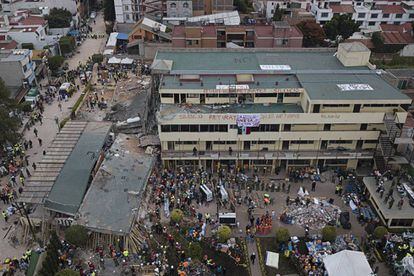Tragedy in a Mexican school: “We’re not leaving until they get the last person out”
The families of the victims of the Enrique Rebsamen school leveled by the earthquake wait anxiously as rescue teams work around the clock

The Nueva Oriental Coapa residential area is shrouded in darkness, relieved only by the lights of the emergency vehicles. Like many of the neighborhoods to the south of Mexico City, there was a complete blackout following the 7.1 magnitude earthquake on Tuesday afternoon. The shouts of the volunteers serve as a guide.
“We need hydraulic jacks, cutting discs, fire extinguishers, flexometers – wheelbarrows to take off the debris,” shouts a woman as more volunteers arrive. Following the tremors, the Enrique Rebsamen school folded in on itself, trapping dozens of children under the rubble. So far, 32 youngsters and five adults are confirmed dead.
The school has 347 students on the register – 32 in preschool, 185 in elementary and 130 in high school as well as 27 teachers and fellow members of staff. No one knows exactly how many people were there when the earthquake struck. A member of the local authorities believes that there were 117. The top of the building housed the school principal. Management offices occupied the second floor. The first floor was where the children waited to be picked up by their parents.
I got a ring tone after the tremors. Then the line went dead
César Ruiz, relative of missing person
But at midnight on Tuesday, the school was nothing more than a pile of rubble in a middle class neighborhood that had buried a truck and trapped around 50 people. Some blocks away, Malena Ruiz, owner of a local store, was sitting on a bench in the darkness after hours of volunteering alongside the emergency services. “We are not equipped for this kind of thing,” she said. “Help was a long time coming.”
“There were four seconds between the time the alarm went off and the school collapse,” said a high school student, who prefers to remain anonymous. Just 12 years old, she was packing her yoga mat after an extra-curricular class at the school and had to run barefoot under a hail of stones, glass and other debris to get out. “People were bleeding,” she said. “They were all injured.”
Three of her 14 classmates died. Three more are missing and one is injured. “I feel really bad for the people who are still trapped,” she says. “I feel sorry for the parents who have lost their children but I also feel really lucky because I got out alive.” The first rescue workers to arrive on the scene were just ordinary people – young students from the National Autonomous University of Mexico, who came with spades and pick axes and buckets as soon as tragedy struck. The army arrived an hour later and asked them to leave but they had already earned the right to stay.
At midnight, everyone worked tirelessly side by side – firemen with students, marines with locals. Together, stifled by the petrol fumes from generators, they managed to wrench aside bits of door, broken chairs and glass from the rubble, which were then carted away in supermarket trolleys.
There were four seconds between the time the alarm went off and the school collapsed
12-year-old survivor
Not far away, the authorities had set up a field hospital on basketball courts and lined up the bodies found under the rubble. Families of the missing were waiting for news on the other side of the street where the local police had set up a table to attend to the victims. Nobody wanted to have to go to the table. Cordoned off by police, it could only mean bad news.
Around 4am, a doctor approached the table and started to cry, “There’s Lalo! There’s Lalo!” A policeman and a Red Cross worker had to hold him up to stop him from collapsing. He had spent most of the afternoon looking in local hospitals for his seven-year-old son. Now his search was at an end and all that was left to do was to formally identify the body from the clothes and wrist watch. Other families stayed put, watered and fed by the Mexican armed forces. No one wanted to be in the doctor’s shoes.
Among those still waiting for news was César Ruiz from Milpa Alta, a region to the south of the city. He was looking for his 35-year-old aunt, Gloria González Ruiz, who worked for the school principal. The family of Reina Dávila, another member of the school’s staff, slept on some mattresses scattered on the ground. Her brother hadn’t heard from her since Tuesday afternoon. “I got a ring tone after the tremors. Then the line went dead,” he says. Pulling a blanket over himself, he added: “We’re not leaving until they get the last person out.”
English version by Heather Galloway.










































